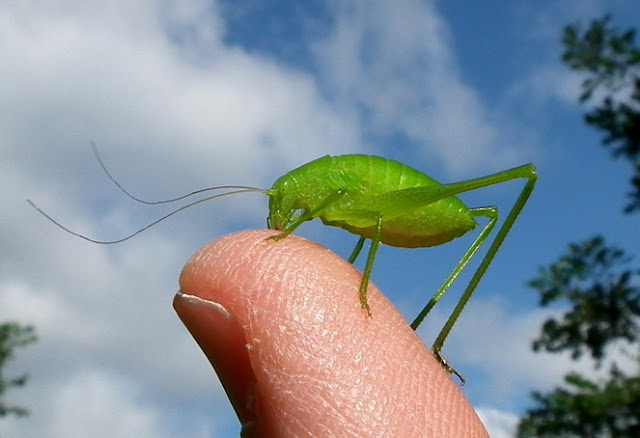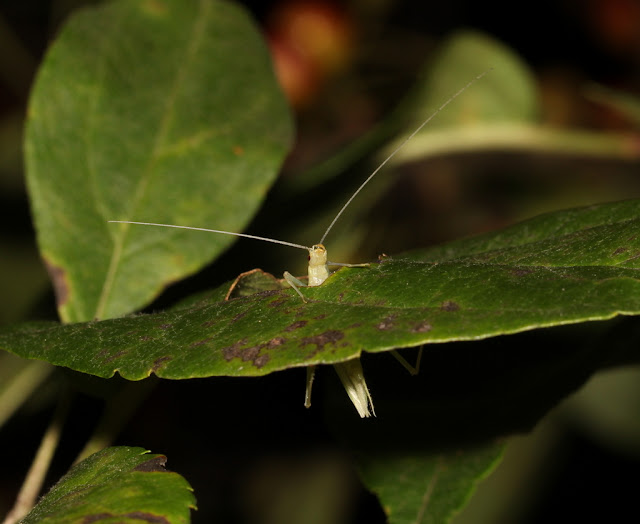Rattler Round-winged Katydid
This is the season for the early spring birdsong and maybe even the earliest frog songs. So why am I creating a post about cricket and katydid songs when we're still a month from the spring equinox?
It's not just my impatience for singing insect season. I’ve already written a number of posts on early-season bird and frog songs that have included species comparisons and how to listen. Yet I seldom seem to get a chance to include song comparisons for singing insects. Why? Because I'm out in the field so much during their season of song, inevitably creating a collection of recordings and photos that take months (or longer) to edit.
So I've decided to write those listening skills posts now. You’ll know where to review them later in the year, and eventually, they will be part of a much larger project. You can always check the blog sidebar for my previous posts on early spring singers, and I keep a list of upcoming programs there as well. And remember, the first Spring Field Crickets will begin singing in May. That’s not so far away, is it?
“What happened to all the crickets?"
"Why are there no crickets this year?”
Every June, posts of great dismay about the abnormal absence of singing crickets will inevitably appear on Facebook and elsewhere. What people don’t realize is that June is simply too early for all but a very few species of crickets or katydids to be singing in our area and regions similar to ours. No need to panic; they just haven’t matured yet.
Almost all of our singing insects overwinter as eggs, which is why we don’t hear most of our crickets and katydids until later July or August. They literally have to grow their instruments.
Amblychorypha katydid nymph
Rattler Round-winged Katydid adult
Cricket and katydid instruments are at the base of their upper set of wings (the tegmina). One wing has a file at its base and the other has a scraper. They move their wings across each other at a very high rate of speed and do so either continuously or in short bursts, creating either long, steady trills or a rhythmic pattern of shorter songs.
A katydid’s left wing, which has the "file," crosses over the top of the right wing, which has the "scraper" that extends upward to the file.
In contrast, a cricket’s right wing crosses above and over the left wing.
Gladiator Meadow Katydid: left wing over right
In contrast, a cricket’s right wing crosses above and over the left wing.
These insects also have an additional set of flight wings beneath the tegmina, though some species don't actually fly. This lower set of wings is not involved in song production.
Some katydids have short – or even very short – wings, yet they still can generate sound. Here is an adult Straight-lanced Meadow Katydid - look at those tiny wings!
Let’s also take a look at these insects' wing positions while singing. There’s quite a bit of variety, and I think you'll find this to be helpful information in the field.
Tree crickets are the most dramatic. A male tree cricket holds his wings against his body until he’s going to sing.
Then he raises his wings until they are perpendicular to his body. At this point, the file and scraper are in position to create a song that's surprisingly loud for such a small insect.
Broad-winged Tree Cricket
Then he raises his wings until they are perpendicular to his body. At this point, the file and scraper are in position to create a song that's surprisingly loud for such a small insect.
Broad-winged Tree Cricket singing
What if they could broadcast their songs to interested females even more effectively with additional amplification beyond that of their beautiful wings? In fact, some tree crickets use the lobes of a leaf, two adjoining leaves, or even a hole in a leaf to create a larger surface that amplifies their songs.
Snowy Tree Cricket
Davis's Tree Cricket
Davis's Tree Cricket
Ground crickets and field crickets don’t raise their wings as high as the tree crickets, and they generally sing from hiding places.
Allard's Ground Cricket singing on a fallen leaf in the sun
They may use anything from cracks in the pavement to rocks in a garden or drainage area to create resonance for their songs.

Fall Field Cricket singing
Some sing under leaf litter on the forest floor and others from deep within a clump of grass. We may not see them, but we can certainly hear them.
Jumping Bush Crickets and Handsome Trigs raise their wings higher than ground and field crickets and will sing from twigs, leaves, branches, and even hidden within a curled-up leaf.
Jumping Bush Cricket revealed
Handsome Trig sings from his hiding place
Unlike many of the cricket species, katydids don't raise their wings much above their bodies. Depending on the species, katydids can sing from a grass stem, a tree branch, the top of a wildflower like Joe Pye, a shrub, or from cattails.
Common True Katydids sing up in the trees. Between their incredibly leaflike wings and their location well above our heads, we don’t often have the opportunity to observe their performances. On one of my public singing insects walks at Lake Metroparks’ Environmental Learning Center, however, two participants spent 30 minutes searching for a singer they were certain was right above their heads. Their persistence paid off: here he is!
Common True Katydid
Let's look next at three of the meadow katydids in the genus Orchelimum. Black-legged Meadow Katydids often sing from cattails or bulrushes in wetlands. They prefer a thick stem for a solid, secure singing perch.
Black-legged Meadow Katydid
Their early summer relatives, the Gladiator Meadow Katydids, sing from grass stems such as reed canary grass (an invasive non-native plant that does happen to provide the required amount of support). They may even sing on a timothy (pasture grass) seed head, where they will also enthusiastically dine on the seeds.
Gladiator Meadow Katydid
In upland meadows, their Common Meadow Katydid cousins sing from grasses and wildflowers in drier habitats.
Common Meadow Katydid
All three of these meadow katydids raise their wings just enough that we can observe the rapid wing movement. For an example, please see Wil Hershberger’s Black-legged Meadow Katydid video on The Songs of Insects here.
Smaller meadow katydids from the genus Conocephalus seem to barely raise their wings at all, but you may still be able to observe their songs if you’re close enough.
Short-winged Meadow Katydid singing
The songs typically consist of some initial “tics" immediately followed by long “whirrs,” so watch for what appears to be rapid vibration of the wings. At times, the visual clues have been my only confirmation that I should turn on my recorder, as the songs are very high and soft to many human ears. Close observation was very helpful when recording this Black-sided Meadow Katydid, as I couldn't even hear him singing with the louder Black-legged Meadow Katydids nearby.
Black-sided Meadow Katydid singing on a cattail
The larger katydids that are such impressive leaf mimics generally have songs consisting primarily of a series of percussive “tics.” You may be able to see their subtle, almost horizontal-appearing wing movement, but as with meadow katydids, the wings will not be raised very high. Songs will appear more like wing flicks than long vibrations.
Bush katydids (genus Scudderia) will climb up to the tops of flowers and sing from these elegant stages at night and occasionally in the late afternoon if the nights are too chilly. I find females there as well.
This Texas Bush Katydid (above) used these asters for his afternoon performance.
This Curve-tailed Bush Katydid female (below) was walking across the tops of the
goldenrod flowers. A singing male was nearby - a lovely location for a romantic evening..
Rattler Round-winged Katydids and Oblong-winged Katydids may sing from a leaf that provides a small platform stage. Greater Angle-wings, however, will generally sing in trees or the tops of tall shrubs.
Oblong-winged Katydid
Conehead katydids have longer rattling or buzzing songs. If your high-frequency hearing is intact, they may seem almost annoyingly loud. If those frequencies are less apparent than they once were, you may have difficulty hearing some of these coneheads because their songs are quite high - typically above 10,000 Hz.
Sword-bearing Coneheads typically sing from plants that have a stems heavy enough to support these sizable katydids. Their wings are somewhat raised and their rapid, vibrating songs will be visually apparent. They frequently seem to stroll around their plants, alternating between upside-down and right side-up positions while they sing.
Sword-bearing Conehead
Nebraska Conehead singing
Coneheads can often be observed singing, and insect song hike participants invariably consider the discovery of a concertizing conehead to be the highlight of the evening.
Sword-bearing Conehead walking while singing
Future posts will include comparisons of species with similar songs so that you can begin to separate the singers in night chorus. Another very helpful guideline will be a description of songs by habitat: who sings with whom in various NE Ohio's meadows, marshes, woodlands, and shrubby edgres and fields. I'll also create a timeline of which species sing in early summer through those that sing until a hard frost.
As with birds, not everyone sings simultaneously or in the same location. Once we can narrow down the choices for a particular time and place, learning the singers and their songs becomes considerably easier!
As with birds, not everyone sings simultaneously or in the same location. Once we can narrow down the choices for a particular time and place, learning the singers and their songs becomes considerably easier!
































Interestingly, the local Scudderia appear to be semi-diurnal and sing/eat intermittently at all times of day.
ReplyDeleteThey do stridulate more vigorously at night, though.